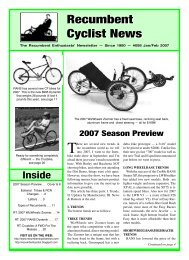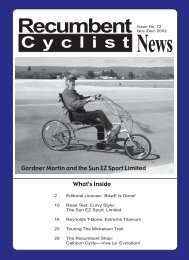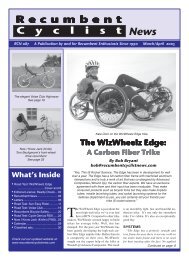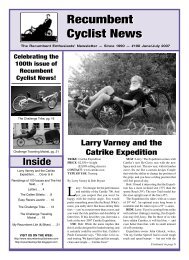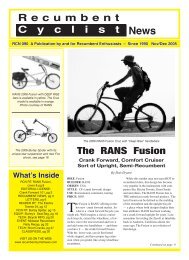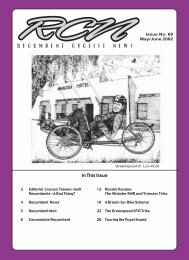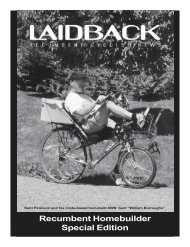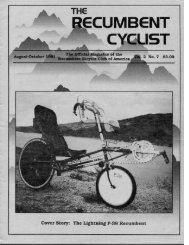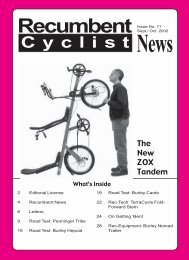What's Inside
What's Inside
What's Inside
You also want an ePaper? Increase the reach of your titles
YUMPU automatically turns print PDFs into web optimized ePapers that Google loves.
the KMC chain links (Quick Links) must be<br />
replaced every time you remove the chain and<br />
are not always easy to find (so keep spares). I<br />
wouldn’t go out of my way to replace a new<br />
KMC chain until it was worn out or I was heading<br />
out on a major tour.<br />
When it comes time to replace it, I would opt<br />
for a SRAM (formerly Sachs) chain, which I<br />
consider to be the best bicycle chain available.<br />
SRAM generally shifts better, lasts longer, and<br />
is more trouble-free.<br />
I recently had the opportunity to fit Shimano<br />
chains to a recumbent, and what a painful experience<br />
it was. They use break-off push pins<br />
to splice the links. I ended up using four pins<br />
in one chain, broke a chain tool and was still<br />
concerned about the chain’s strength. Stick with<br />
SRAM and your chain problems should be kept<br />
to a minimum.<br />
SUSPENSION FORKS<br />
The best recumbent suspension is one that is<br />
already integrated into the bike design — such<br />
as those available from HP Velotechnik (Spirit)<br />
and Cannondale. These are well thought-out<br />
systems with the suspension inside the fork, and<br />
are the best I’ve tested. HP Velo is also using a<br />
new fork, the Spinner Grind2, which we haven’t<br />
seen yet. Aftermarket forks are also available<br />
from Meks, Ballistic and White Brothers.<br />
The biggest negative about suspension forks<br />
is the added cost of the fork, and for additional<br />
maintenance costs (rebuilds). Be sure to ask<br />
how often service is required on your fork.<br />
Lighter Weight Forks: Highracers can benefit<br />
from lighter carbon fiber forks. Check out the<br />
bike forums for the latest information. RANS<br />
offers a house-brand aluminum fork upgrade<br />
(and standard on some models). These forks<br />
are lightweight options, and probably not ideal<br />
for fork commuting, touring or heavy riders.<br />
REAR SUSPENSION<br />
A cushy ride can be wonderful and will spoil<br />
you. Suspension is best for urban commuters,<br />
small-wheeled bikes, tourers and those who ride<br />
on rough roads. Rider/load combinations over<br />
200 pounds should look into the availability of<br />
optional heavier springs. Suspension can complicate<br />
fender and rack mounting, adds weight<br />
to the bike, is more expensive, and requires<br />
more maintenance (shock replacement can<br />
cost hundreds of dollars).<br />
The best recumbent suspension designs<br />
have low pivot points for the rear swing arm.<br />
Consider your body weight and if your cargo<br />
weight will also be supported by suspension.<br />
Pogo, or pedal-induced suspension movement<br />
is the sign of a marginal suspension system.<br />
A cheaper alternative is to run fatter<br />
low pressure tires like Schwalbe Big<br />
Apples (see www.balloonbikes.com and<br />
www.schwalbetires.com).<br />
Some frames have more flex to them, and<br />
steel frames are usually more forgiving. Larger<br />
diameter wheels generally ride smoother than<br />
smaller wheels. Steel frames are more forgiving<br />
and have a smoother ride than aluminum, and<br />
titanium will have the smoothest ride (although<br />
some think titanium is too flexible).<br />
HEADSET<br />
One interesting aspect of recumbency is<br />
that not all manufacturers are using threadless<br />
steerer tubes, even on some high-end bikes.<br />
Many companies have unique threadless<br />
clamping systems. Some systems are really<br />
good, and others are just okay. You’ll know<br />
by how difficult installation and adjustments<br />
are. Some threaded headsets can’t be upgraded<br />
without spending big bucks, so ask questions<br />
before you buy.<br />
As far as headsets go, the differences are<br />
the quality of the bearing, cartridge-sealed vs.<br />
caged bearing, ease of adjustment, and quality<br />
of materials. A headset can cost from a few<br />
bucks to over $100. I really like cartridge-sealed<br />
bearing headsets. Two excellent examples are<br />
the Chris King and Ritchey WCS. The Ritchey<br />
WCS lifetime headset has precision machined<br />
aluminum cups, angular cartridge sealed bearings<br />
and is more affordable than a Chris King.<br />
Angletech offers the WCS on several models.<br />
Watch out for non brand name brand mediocre<br />
headsets. Recumbents can put more pressure<br />
on a headset than a road bike, so this isn’t a<br />
place to cheap out. This isn’t something to run<br />
out and replace right away, but if you build up<br />
from a frameset, get a good one.<br />
PEDALS<br />
Most bicycle enthusiasts these days use<br />
clipless pedals. This means that your pedals<br />
have a snow ski-type binding and your shoes<br />
have a cleat that snaps into the binding. Finding<br />
the system that works best for you can be a<br />
time-consuming and expensive task. The most<br />
popular brand of pedals is the Shimano SPD<br />
(Shimano Pedaling Dynamics). SPD pedals<br />
have become the industry standard primarily<br />
because they are easy to use and are relatively<br />
affordable. Some enthusiasts favor BeBops<br />
(www.bebop.com) because they have lots of<br />
float. I’ve had at least one report of reluctant<br />
engage and release in touring conditions with<br />
Bebops. Sadly, these have been discontinued<br />
but may be reintroduced at a later date by a<br />
new maker. Others prefer Crank Brothers Egg<br />
Beaters (www.crankbrothers.com) which have<br />
easy entry/exit (four possible entry positions<br />
compared with two with BeBops or SPDs).<br />
I’ve used Egg Beaters and was unhappy with<br />
the durability. I like Shimano SPD because the<br />
design is time proven.<br />
Some riders experience pain using clipless<br />
pedals (from having your feet in the same position).<br />
Harry Wozniak of Wheel & Sprocket<br />
likened the pain to standing on a ladder for an<br />
extended time. The problem is that clipless<br />
systems were designed for upright bicycles.<br />
- 24 -<br />
Recumbent clipless systems need to have<br />
the cleats mounted further back on the shoe.<br />
Sometimes there isn’t enough room on the<br />
clipless cleat mounting tracks to mount far<br />
enough toward the middle of the shoe. Some<br />
riders modify their shoes with a Dremel tool,<br />
others just ride with incorrect positioning, and<br />
others stop using their clipless pedals in favor<br />
of basic platform pedals.<br />
I use platform pedals and Shimano cycling<br />
shoes for most of my riding. They work especially<br />
well for commuting and on recumbents<br />
with low to medium (seat height) crank positions.<br />
The higher the crank, the more you may<br />
need a foot retention device.<br />
Thanks to the component makers building<br />
parts for Freeride and Downhill style mountain<br />
biking, we now have some really cool platform<br />
pedals to choose from. After breaking a rather<br />
inexpensive oval caged bear trap pedal (the<br />
bike fell over and bent the cage and spindle),<br />
I recently switched to aluminum pinned pedals.<br />
Look for a CNC aluminum or magnesium<br />
body, removable pins, a ChroMoly spindle and<br />
cartridge bearings. The pins act as upside-down<br />
toe clips, though I can vary my foot positions<br />
as I wish. Cool pedals like this can be found<br />
from Sun/Ringle (Zu Zu), Wellgo (Magnesium),<br />
Azonic, Truvativ (Holzfeller) and Syncros<br />
(Mental). Angletech sells a few of these, and<br />
others can be found at www.mtbr.com.<br />
These pinned pedals hold my Shimano shoes<br />
to the pedals and allow me to vary my foot’s<br />
placement on the pedal. I know I’m in a minority<br />
of non-clipless users, but I’m extremely<br />
happy with my retro pedal choices. Racers and<br />
other performance cyclists may need to use clipless,<br />
but commuters, recreational cyclists and<br />
tourists really don’t need to. One last option is<br />
the Power Grip strap. This is a diagonal strap<br />
that crosses the platform pedal. You slip your<br />
foot in at an angle, straighten it, and the strap<br />
holds you in. Ask for these at your local bike<br />
or recumbent shop.<br />
SHOES<br />
If fit is everything, cleat placement is a close<br />
second. On a recumbent the cleats should be<br />
mounted more towards the center of the shoe,<br />
so be careful before you lay down your hardearned<br />
cash.<br />
Angletech sells SIDI shoes which are very<br />
high quality and come in wide sizes. I prefer<br />
the basic Shimano SH-M021G that cost just<br />
over $50. They are relatively flat-soled and<br />
have laces instead of Velcro straps. These are<br />
my favorite bike shoes — ever.<br />
WHEELS<br />
Here are the common recumbent wheel<br />
sizes:<br />
• 16” 305 mm: This smaller diameter and<br />
wider 16” size is found on recreational<br />
CLWB models.



